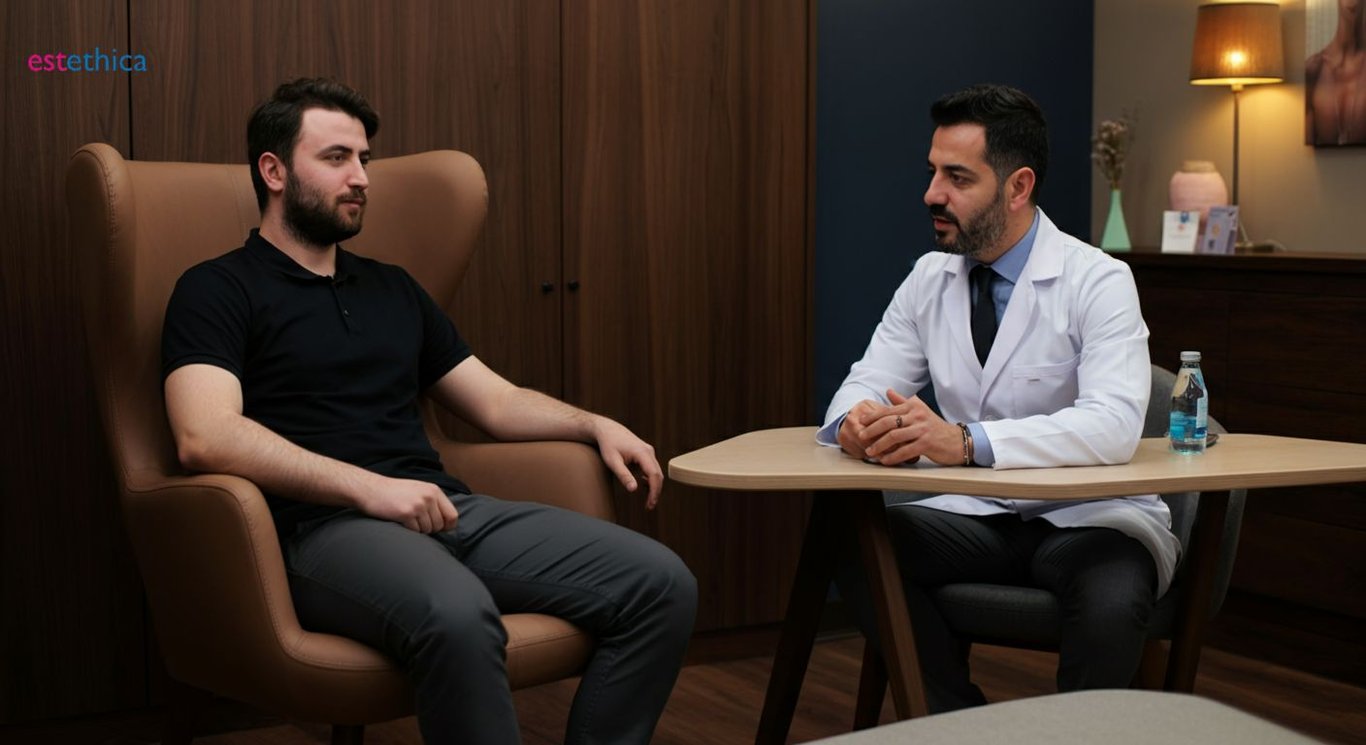Gynecomastia Surgery: Transform Your Confidence
Transform your confidence with gynecomastia surgery. Learn about treatment options and what to expect for a confident new you.
Gynecomastia is a medical condition that causes the enlargement of breast tissue in males. It often results from a hormonal imbalance, leading to increased levels of estrogen and decreased levels of testosterone. These changes can cause significant emotional distress and affect self-confidence, prompting many to seek medical advice. Understanding the condition, its symptoms, and causes is the first step toward appropriate treatment.
Understanding Gynecomastia: Causes and Symptoms
Hormonal Imbalances and Their Impact
Gynecomastia primarily results from hormonal imbalances, specifically an excess of estrogen or a deficit in testosterone. These imbalances are common during adolescence and in older men, making them particularly susceptible. For instance, during puberty, boys experience fluctuating hormone levels, which can temporarily lead to enlarged male breasts. Similarly, older men may face hormonal changes due to aging, contributing to gynecomastia. Additionally, certain medications, such as anti-androgens used for prostate conditions, can exacerbate this condition. Substances like alcohol and recreational drugs also play a role in hormonal disruption, leading to symptoms such as swollen breast gland tissue, tenderness, and sometimes nipple discharge.
Contributing Factors to Gynecomastia
- Medications: Anti-androgens, anabolic steroids, and some antidepressants can lead to gynecomastia.
- Lifestyle Choices: Excessive alcohol consumption and drug use disrupt hormonal balance.
- Health Conditions: Liver and kidney diseases can alter hormone levels, contributing to the condition.
Understanding these factors is crucial for identifying potential causes and exploring transformative gynecomastia surgery insights for effective treatment.
Symptoms and Diagnosis
- Initial Signs: Swelling and tenderness in the breast area are early indicators.
- Advanced Symptoms: Persistent pain and nipple discharge may occur as the condition progresses.
- Medical Evaluation: A thorough examination and hormone level tests help confirm the diagnosis.
Recognizing these symptoms early can lead to timely intervention and treatment, potentially reducing the need for more invasive procedures like gynecomastia surgery.

Natural Approaches to Treat Gynecomastia
Balancing Hormones Through Diet and Lifestyle
Addressing gynecomastia naturally often involves dietary and lifestyle changes aimed at balancing hormones. A diet rich in whole foods, such as fruits, vegetables, and lean proteins, can support hormonal health. For example, incorporating cruciferous vegetables like broccoli and kale may help reduce estrogen levels due to their high content of indole-3-carbinol. Additionally, regular exercise not only aids in reducing body fat but also boosts testosterone levels, potentially mitigating the effects of gynecomastia.
Natural Supplements and Their Role
- Fenugreek: Known for its potential to increase testosterone levels naturally.
- Turmeric: Contains curcumin, which may help balance estrogen levels.
- Zinc: Essential for testosterone production and hormonal balance.
While these supplements can be beneficial, it's crucial to consult with a healthcare provider before starting any new regimen, especially to avoid interactions with existing medications.
Steps to Implement Natural Treatments
- Evaluate Diet: Focus on whole foods and reduce processed food intake.
- Incorporate Exercise: Engage in regular physical activity to enhance metabolism and hormone levels.
- Consult a Professional: Seek guidance on safe supplement use and monitor progress.
These steps can help manage gynecomastia symptoms naturally, although they may not replace the need for medical interventions like gynecomastia surgery in severe cases.

Choosing the Best Gynecomastia Surgeon Near You
Evaluating Surgeon Credentials and Experience
When selecting a surgeon for gynecomastia surgery, it's crucial to assess their credentials and experience. Look for board certifications in plastic surgery, which indicate a high level of training and expertise. Additionally, consider the surgeon's experience with male breast reduction procedures specifically. A surgeon who has performed numerous gynecomastia operations is likely to have refined their technique, leading to better outcomes. For example, a surgeon with over a decade of experience in gynecomastia surgery may offer insights into the latest techniques and technologies, enhancing the overall treatment process.
Understanding the Consultation Process
- Initial Assessment: Discuss your medical history and expectations with the surgeon.
- Procedure Explanation: Learn about the surgical approach and recovery timeline.
- Risk Discussion: Understand potential complications and how they are managed.
These consultations are vital for building trust and ensuring that you are comfortable with the surgeon's approach. They also provide an opportunity to ask questions about the best way to get rid of man boobs and explore non-surgical gynecomastia solutions if surgery isn't the preferred option.
Factors Influencing the Cost of Gynecomastia Surgery
- Surgeon's Expertise: More experienced surgeons may charge higher fees.
- Clinic Location: Costs can vary significantly based on geographic location.
- Procedure Complexity: The extent of the surgery can affect the overall price.
While cost is an important consideration, it should not be the sole factor in choosing a surgeon. Prioritize quality and safety to ensure the best possible outcome for your gynecomastia operation.

Surgical Treatment Options
Understanding the Surgical Procedure for Gynecomastia
Surgical intervention is often the most effective gynecomastia treatment, particularly for those seeking permanent results. The procedure typically involves the excision of excess glandular tissue, which is the primary cause of enlarged male breasts. This excision is crucial for achieving a flatter, more masculine chest contour. In many cases, liposuction is also employed to remove additional fatty tissue, enhancing the overall aesthetic outcome. For instance, a patient with significant fatty deposits may benefit from a combination of tissue excision and liposuction, resulting in a more natural appearance.
Factors Affecting the Cost of Gynecomastia Surgery
- Procedure Complexity: The extent of tissue removal can influence the surgical approach.
- Surgeon's Expertise: Experienced surgeons may offer advanced techniques for better results.
- Geographic Location: Costs can vary based on the region and clinic facilities.
While the cost of gynecomastia surgery is a consideration, the focus should remain on the quality of care and the surgeon's expertise to ensure a successful outcome.
Post-Surgery Recovery and Expectations
- Initial Recovery: Patients typically experience swelling and discomfort, which subsides within weeks.
- Follow-up Care: Regular check-ups are essential to monitor healing and address any concerns.
- Long-term Results: Most patients enjoy permanent results, with a significant improvement in chest appearance.
Understanding the recovery process is crucial for setting realistic expectations and ensuring a smooth transition to post-operative life. This knowledge helps patients prepare for the journey ahead, leading to a more satisfying experience.
Safety and Recovery: What to Expect Post-Surgery
Post-Surgical Care and Recovery Process
Post-surgical recovery is a critical phase in gynecomastia treatment, ensuring optimal healing and results. Patients are advised to wear compression garments, which help minimize swelling and provide necessary support to the healing tissues. These garments are typically worn for several weeks, aiding in the reduction of discomfort and promoting a smoother recovery.
Key Recovery Steps
- Initial Rest: Patients should prioritize rest and avoid strenuous activities to facilitate healing.
- Follow-Up Appointments: Regular check-ups with the surgeon are essential to monitor progress and address any concerns.
- Long-Term Care: Adhering to the surgeon's advice on lifestyle adjustments can enhance recovery outcomes.
These steps are crucial for ensuring a successful recovery, allowing patients to enjoy the benefits of their gynecomastia operation fully.
Potential Complications and Their Management
- Minor Scarring: While scarring is a natural part of healing, professional care can minimize its appearance.
- Infection Risks: Adhering to prescribed care routines significantly reduces the risk of infection.
- Swelling and Discomfort: These are common post-surgery but typically subside with proper care and time.
Understanding these potential complications and their management is vital for patients to feel confident and prepared for their recovery journey. With professional guidance, most issues are manageable, ensuring a smooth transition to post-operative life.
Advanced Hormonal Balancing Techniques for Gynecomastia
Seamless Recovery and Long-Term Results in Gynecomastia Care
Frequently Asked Questions
What is gynecomastia and what causes it?
Can gynecomastia go away on its own?
How can gynecomastia be treated naturally?
Is gynecomastia surgery safe?
What should I expect during the recovery from gynecomastia surgery?
Discover the path to 'Healthy Beauty' with estethica's expert care. Call now for your free consultation and take the first step towards a more confident you!
📞 Speak with Our Specialists Today!